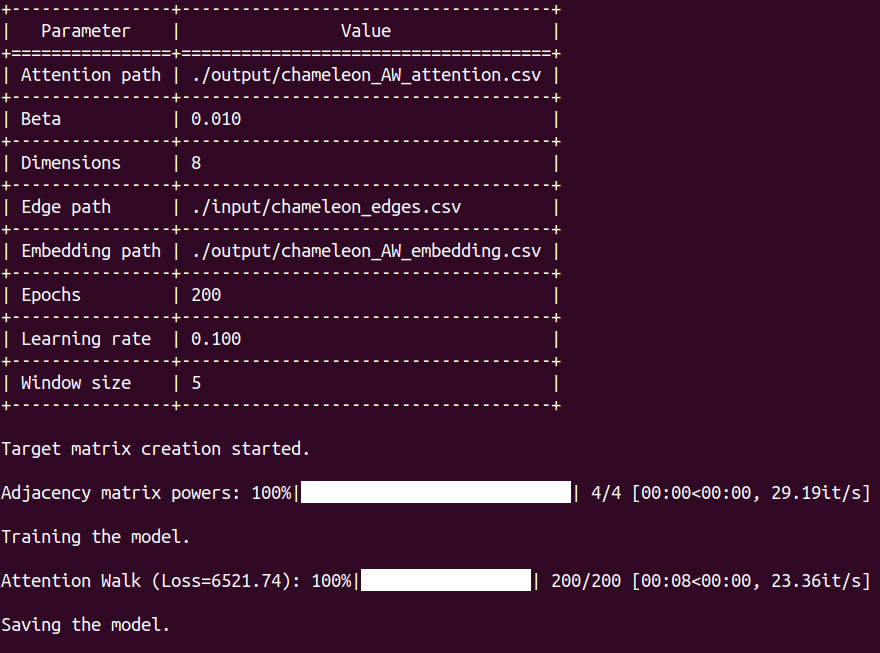A PyTorch Implementation of "Watch Your Step: Learning Node Embeddings via Graph Attention" (NIPS 2018).
Graph embedding methods represent nodes in a continuous vector space, preserving different types of relational information from the graph. There are many hyper-parameters to these methods (e.g. the length of a random walk) which have to be manually tuned for every graph. In this paper, we replace previously fixed hyper-parameters with trainable ones that we automatically learn via backpropagation. In particular, we propose a novel attention model on the power series of the transition matrix, which guides the random walk to optimize an upstream objective. Unlike previous approaches to attention models, the method that we propose utilizes attention parameters exclusively on the data itself (e.g. on the random walk), and are not used by the model for inference. We experiment on link prediction tasks, as we aim to produce embeddings that best-preserve the graph structure, generalizing to unseen information. We improve state-of-the-art results on a comprehensive suite of real-world graph datasets including social, collaboration, and biological networks, where we observe that our graph attention model can reduce the error by up to 20%-40%. We show that our automatically-learned attention parameters can vary significantly per graph, and correspond to the optimal choice of hyper-parameter if we manually tune existing methods.
This repository provides an implementation of Attention Walk as described in the paper:
Watch Your Step: Learning Node Embeddings via Graph Attention. Sami Abu-El-Haija, Bryan Perozzi, Rami Al-Rfou, Alexander A. Alemi. NIPS, 2018. [Paper]
The original Tensorflow implementation is available [here].
The codebase is implemented in Python 3.5.2. package versions used for development are just below.
networkx 1.11
tqdm 4.28.1
numpy 1.15.4
pandas 0.23.4
texttable 1.5.0
scipy 1.1.0
argparse 1.1.0
torch 1.0.0.
torchvision 0.2.1
The code takes an input graph in a csv file. Every row indicates an edge between two nodes separated by a comma. The first row is a header. Nodes should be indexed starting with 0. Sample graphs for the Twitch Brasilians and Wikipedia Chameleons are included in the input/ directory.
Learning of the embedding is handled by the src/main.py script which provides the following command line arguments.
--edge-path STR Input graph path. Default is `input/chameleon_edges.csv`.
--embedding-path STR Embedding path. Default is `output/chameleon_AW_embedding.csv`.
--attention-path STR Attention path. Default is `output/chameleon_AW_attention.csv`.
--dimensions INT Number of embeding dimensions. Default is 128.
--epochs INT Number of training epochs. Default is 200.
--window-size INT Skip-gram window size. Default is 5.
--learning-rate FLOAT Learning rate value. Default is 0.01.
--beta FLOAT Attention regularization parameter. Default is 0.5.
--gamma FLOAT Embedding regularization parameter. Default is 0.5.
--num-of-walks INT Number of walks per source node. Default is 80.
The following commands learn a graph embedding and write the embedding to disk. The node representations are ordered by the ID.
Creating an Attention Walk embedding of the default dataset with the standard hyperparameter settings. Saving this embedding at the default path.
python src/main.py
Creating an Attention Walk embedding of the default dataset with 256 dimensions.
python src/main.py --dimensions 256
Creating an Attention Walk embedding of the default dataset with a higher window size.
python src/main.py --window-size 20
Creating an embedding of another dataset the Twitch Brasilians. Saving the outputs under custom file names.
python src/main.py --edge-path input/ptbr_edges.csv --embedding-path output/ptbr_AW_embedding.csv --attention-path output/ptbr_AW_attention.csv




